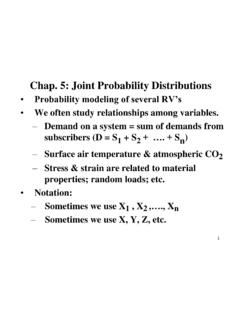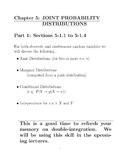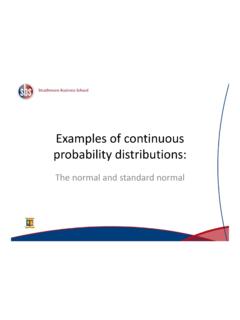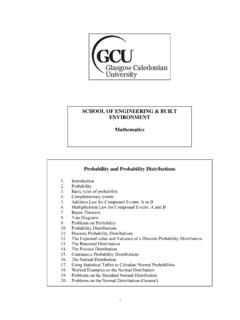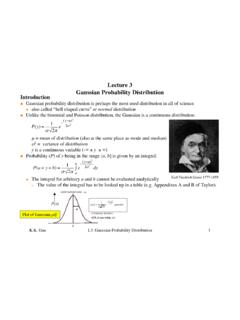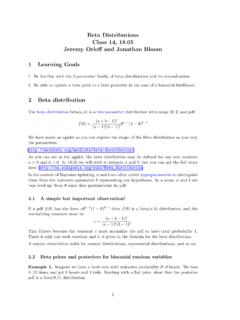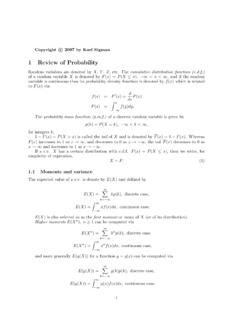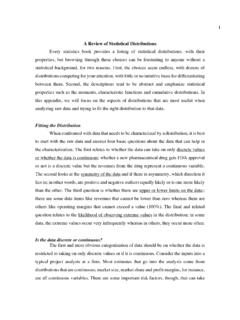Transcription of Conditional Joint Distributions
1 Conditional Joint DistributionsChris PiechCS109, Stanford UniversityTracking in 2D Space? Joint Random VariablesUse a Joint table, density function or CDF to solve probability questionUse and find independenceof random variablesThink about conditionalprobabilities with Joint variables (which might be continuous)What happens when you addrandom variables?Use and find expectationof random variablesJoint Random VariablesUse a Joint table, density function or CDF to solve probability questionUse and find independenceof random variablesThink about conditionalprobabilities with Joint variables (which might be continuous)What happens when you addrandom variables?
2 Use and find expectationof random variablesJoint probability TableRoommates2 RoomDblShared + Joint Random Variables0yx900900A Joint probability density functiongives the relative likelihood of more than one continuous random variable each taking on a specific value. = < <2121 ),( ) ,(P,2121aabbYXdxdyyxfbYbaXaJoint probability Density Function0yx9009000900900 Four Prototypical TrajectoriesEnd Review Cumulative Density Function (CDF): - -=abYXYX dxdyyxfbaF ),( ),(,,),(),(,2, baFbafYXYXba =Jointly Continuous = < <2121 ),( ) ,(P,2121aabbYXdxdyyxfbYbaXa!",$%,&=() %,+ &%&to 0 asx - ,y - ,to 1 asx + ,y + ,plot by AcademoJointly CDF!
3 "#<% "',)#<* )'=,-,."',)'a1a2b1b2 Probabilities from Joint CDF!"#<% "',)#<* )'=,-,."',)'a1a2b1b2 Probabilities from Joint CDF!"#<% "',)#<* )'=,-,."',)'a1a2b1b2 Probabilities from Joint CDF!"#<% "',)#<* )'=,-,."',)' ,-,."#,)'a1a2b1b2 Probabilities from Joint CDF!"#<% "',)#<* )'=,-,."',)' ,-,."#,)'a1a2b1b2 Probabilities from Joint CDF!"#<% "',)#<* )'=,-,."',)' ,-,."#,)' ,-,."',)#a1a2b1b2 Probabilities from Joint CDF!"#<% "',)#<* )'=,-,."',)' ,-,."#,)' ,-,."',)#a1a2b1b2 Probabilities from Joint CDF!"#<% "',)#<* )'=,-,."',)' ,-,."#,)' ,-,."',)#+,-,."#,)#a1a2b1b2 Probabilities from Joint CDF!"#<% "',)#<* )'=,-,."',)'.
4 "#,)' ,-,."',)#+,-,."#,)#a1a2b1b2 Probabilities from Joint CDFP robability for Instagram!Gaussian BlurIn image processing, a Gaussian blur is the result of blurring an image by a Gaussian function. It is a widely used effect in graphics software, typically to reduce image noise. BlurIn image processing, a Gaussian blur is the result of blurring an image by a Gaussian function. It is a widely used effect in graphics software, typically to reduce image noise. Gaussian blurring with StDev= 3, is based on a Joint probability distribution :fX,Y(x,y)=12 32e x2+y22 32FX,Y(x,y)= x3 y3 Joint PDFJ oint CDFUsed to generate this weight matrixGaussian BlurfX,Y(x,y)=12 32e x2+y22 32FX,Y(x,y)= x3 y3 Joint PDFJ oint CDFEach pixel is given a weight equal to the probability that Xand Yare both within the pixel bounds.
5 The center pixel covers the area where x and y is the weight of the center pixel?P( <X< , <Y< )=P(X< ,Y< ) P(X< ,Y< ) P(X< ,Y< )+P(X< ,Y< )= 2 + = 2 + ( <X< , <Y< )=P(X< ,Y< ) P(X< ,Y< ) P(X< ,Y< )+P(X< ,Y< )= 2 + = 2 + ( <X< , <Y< )=P(X< ,Y< ) P(X< ,Y< ) P(X< ,Y< )+P(X< ,Y< )= 2 + = 2 + ( <X< , <Y< )=P(X< ,Y< ) P(X< ,Y< ) P(X< ,Y< )+P(X< ,Y< )= 2 + = 2 + ( <X< , <Y< )=P(X< ,Y< ) P(X< ,Y< ) P(X< ,Y< )+P(X< ,Y< )= 2 + = 2 + ( <X< , <Y< )=P(X< ,Y< ) P(X< ,Y< ) P(X< ,Y< )+P(X< ,Y< )
6 = 2 + = 2 + MatrixFour Prototypical TrajectoriesPedagogic PauseFour Prototypical TrajectoriesProperties of Joint DistributionsBoolean Operation on Variable = EventP(X 5)P(Y=6)Recall: any booleanquestion about a random variable makes for an event. For example:P(5 Z 10)Four Prototypical TrajectoriesConditionals with multiple variables Recall that for eventsE and F:0)( )()()|(>=FPFPEFPFEP whereDiscrete Conditional DistributionEFFFE Recall that for eventsE and F: Now, have X and Y as discreterandom variables Conditional PMFof X given Y:0)( )()()|(>=FPFPEFPFEP where)(),()(),()|()|(,|ypyxpyYPyYxXPyYxX PyxPYYXYX========Discrete Conditional DistributionsDifferent notations, same probability TableRoommates2 RoomDblShared + | YearTransport | YearLunch | YearRelationship Status | YearNumber or Function?
7 NumberFunction(or1 Dtable)Number or Function?Number or Function?2D Function(or2D table)P(Buy Book Y | Bought Book X)And It Applies to Books TooP(X=x|Y=y)=P(X=x,Y=y)P(Y=y)fX|Y(x|y) x=fX|Y(x|y) x yfY(y) yfX|Y(x|y)=fX|Y(x|y)fY(y)Continuous Conditional DistributionsLet X and Y be continuous random variablesP(X=x|Y=y)=P(X=x,Y=y)P(Y=y)fX|Y (x|y) x=fX,Y(x,y) x yfY(y) yfX|Y(x|y)=fX,Y(x,y)fY(y)P(X=x|Y=y)=P(X= x,Y=y)P(Y=y)fX|Y(x|y) x=fX,Y(x,y) x yfY(y) yfX|Y(x|y)=fX,Y(x,y)fY(y)Warmup: Bayes RevisitedP(B|E) = P(E|B)P(B)P(E)Posterior beliefPrior beliefLikelihood of evidenceNormalization constantMixing Discrete and ContinuousLet X be a continuous random variableLet N be a discrete random variableP(X=x|N=n)=P(N=n|X=x)P(X=x)P(N=n )PX|N(x|n)=PN|X(n|x)PX(x)PN(n)fX|N(x|n) x=PN|X(n|x)fX(x) xPN(n)fX|N(x|n)=PN|X(n|x)fX(x)PN(n)P(X=x |N=n)=P(N=n|X=x)P(X=x)P(N=n)PX|N(x|n)=PN |X(n|x)PX(x)PN(n)fX|N(x|n) x=PN|X(n|x)fX(x) xPN(n)fX|N(x|n)=PN|X(n|x)fX(x)PN(n)P(X=x |N=n)=P(N=n|X=x)P(X=x)P(N=n)PX|N(x|n)=PN |X(n|x)PX(x)PN(n)fX|N(x|n) x=PN|X(n|x)fX(x) xPN(n)fX|N(x|n)=PN|X(n|x)fX(x)PN(n)P(X=x |N=n)=P(N=n|X=x)
8 P(X=x)P(N=n)PX|N(x|n)=PN|X(n|x)PX(x)PN(n )fX|N(x|n) x=PN|X(n|x)fX(x) xPN(n)fX|N(x|n)=PN|X(n|x)fX(x)PN(n)pN|X( n|x)=fX|N(x|n)pN(n)fX(x)P(X=x|N=n)=P(N=n |X=x)P(X=x)P(N=n)PX|N(x|n)=PN|X(n|x)PX(x )PN(n)fX|N(x|n) x=PN|X(n|x)fX(x) xPN(n)fX|N(x|n)=PN|X(n|x)fX(x)PN(n)All the Bayes Belong to UspM|N(m|n)=PN|M(n|m)pM(m)pN(n)M,N are discrete. X, Y are continuousOG BayesMix Bayes #1 Mix Bayes #2 All ContinuousfX|Y(x|y)=fY|X(y|x)fX(x)fY(y)W armup: Bayes RevisitedP(B|E) = P(E|B)P(B)P(E)Posterior beliefPrior beliefLikelihood of evidenceNormalization constant X, Y follow a symmetric bivariate normal distribution if they have Joint PDF: Warmup: Bivariate NormalfX,Y(x,y)=12 2 e [(x x)2+(y y)2]2 2 Here is an example where: x=3 y=3 =2xyfX,Y(x,y)fX,Y(x,y)-553-55333xy(top view)(side view)Tracking in 2D Space?
9 You have a priorbelief about the 2D location of an is your updated belief about the 2D location of the object after observing a noisy distance measurement?Tracking in 2D Space?Tracking in 2D Space: PriorfX,Y(x,y)=K e [(x 3)2+(y 3)2]8fX,Y(x,y)=12 2 e [(x x)2+(y y)2]2 2xyfX,Y(x,y)-553-553 Prior belief:Prior belief with K: x=3 y=3 =2 Relative to Satellite at (0, 0)You will observe a noisy distance reading. It will say that your object is distance D awayWe can say how likely that reading is if we know the actual location of the P(D | X, Y) is knowable! = actual distance = 1 Tracking in 2D Space: Observation!
10 Observe a ping of the object that is distance D away from satellite!Know that the distance of a ping is normal with respect to the true distance. = actual distance = 1D|X,Y N( =px2+y2, 2= 1)Tracking in 2D Space: Observation!Tracking in 2D Space: Observation!Observe a ping of the object that is distance D= 4 away!Know that the distance of a ping is normal with respect to the true distance px2+y2=4 = actual distance = 1 Tracking in 2D Space: Observation!Observe a ping of the object that is distance D= 4 away!Know that the distance of a ping is normal with respect to the true distance px2+y2=4 = actual distance = 1 Observe a ping of the object that is distance D = 4 away from satellite!










